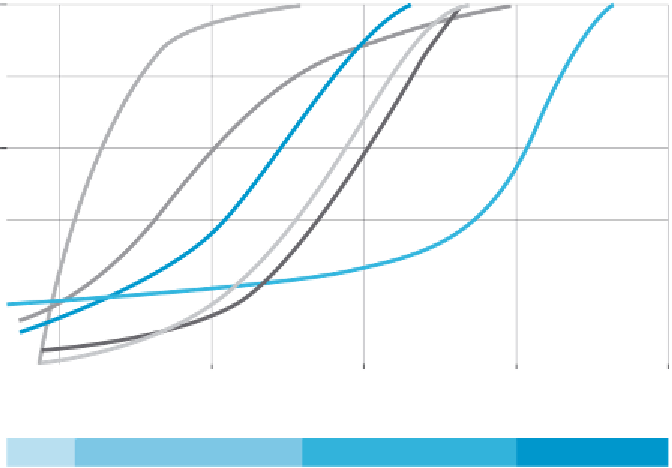Environmental Engineering Reference
In-Depth Information
FIGURE 18.2
Particle Size Distributions for Typical
Tailings
% Finer
100
Bauxite
80
Tailings are commonly in the top three
of the following four grain size distribu-
tion groups:
1. clay - materials less than 2
µ
m;
2. silt - materials lying between 2
µ
m
to 63
µ
m;
3. sand - materials lying between
63
µ
m and 2 mm.
4. gravel - More rarely, they may
contain gravel-sized particles, more
than 2 mm in diameter.
Source:
Sarsby 2000
60
40
20
0
0.001
0.01
0.1
1
10
Particle size (mm)
Clay
Silt
Sand
Gravel
Volume of Tailings
The sheer volume of tailings creates some of the most challenging management problems
in the mining industry. The quantities of tailings produced at most precious and base metal
mines are about the same as the quantity of ore that is mined because ore grades are in the
order of a few percent at most. A high-grade gold ore body may contain tens of grams of
gold per ton (equivalent to one thousandth of 1% gold per ton) while a high grade copper
ore may contain 20 to 30 kg copper per ton (equivalent to 2 to 3 percent copper). Therefore,
even if all commercial minerals are removed, most of the original ore remains as tailings.
A mine producing 100,000 tons of copper ore per day also produces close to 100,000 tons
of tailings. This equates to several thousand truck loads per day of tailings that need to
be managed and disposed of in an environmentally acceptable manner. Where tailings are
stored and how they are managed becomes critical to determining the impacts of mining:
the larger the tailings volume the larger the associated environmental impacts and risks.
A mine producing 100,000
tons of copper ore per day also
produces close to 100,000 tons
of tailings.
Particle Size Distribution
The particle size distribution is one of the most signii cant characteristics of tailings. Prior
to ore benei ciation, most ores are i rst crushed and then milled or ground into i ne parti-
cles. The exceptions are placer gold and tin deposits, and most mineral sand ores where
the valuable minerals already occur as separate grains within essentially granular sedi-
ments. In these situations, little or no crushing or milling is required. In most other cases,
the extent of grinding required depends on the particle size of the mineral grains within
the ore. Most tailings consist predominantly of grains in the i ne sand and silt sizes (2 µm to
0.2 mm), with engineering properties similar to those of silt (Wahler and Associates 1973),
although i ner and coarser gradings are not rare.
Figure 18.2
shows particle size distribu-
tions for several tailings of contrasting particle size distribution.
For on-land disposal systems, particle size distribution is the major factor controlling
tailings deposition, consolidation and desiccation. In general terms, deposition occurs over
days while consolidation requires years or tens of years. Tailings are difi cult to drain; in














Search WWH ::

Custom Search